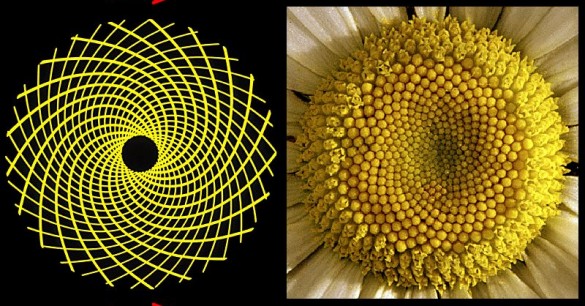
Sunflower Patterns Reveal Complex Mathematical Patterns – Fibonacci “Super Sequences”
May 25, 2016
via mysteriousuniverse
A paper recently published in the Royal Society Open Science journal details how some surprising new patterns have been observed in the faces of Helianthus annuus, the common sunflower. The study, “Novel Fibonacci and non-Fibonacci structure in the sunflower,” details how the researchers found some complex new mathematical patterns after studying the distribution of seeds in sunflower seedheads, the large yellow-petaled flowers that house the plant’s seeds.
The Fibonacci sequence has already been observed widely throughout the structures of living organisms in the natural world, from the spiral of nautilus shells to the geometrical distribution of leaves on plant stems. Even the ratios of the different sizes of many organisms’ physical structures tend to follow Fibonacci sequences, or its derivation into two dimensions as the golden spiral. While other studies of sunflowers found that Fibonacci sequences occur in around 90% of seedheads, this new study found some flowers that display newer, more complex patterns.

Fibonacci spirals are found throughout the natural world
Many of the flowers displayed seed distributions that follow the Lucas numbers, a mathematical pattern similar to the Fibonacci sequence. The Fibonacci sequence begins with 0 and 1, and follows with every subsequent number as the product of adding the previous two numbers (e.g. 0, 1, 1, 2, 3, 5, 8…). The Lucas number keeps the same pattern of adding the previous two numbers, but begins with 2 rather than 0 (2, 1, 3, 4, 7, 11, 18…).
Aside from flowers that show distribution according to Lucas numbers, the study found that 20% of sunflower seedheads display complex patterns that don’t fit into any previously identified sequence, yet still have a high degree of sequentiality. This means these flowers could display “super” patterns that mathematicians have yet to identify and that could reveal deeper iterations of existing patterns such as the Fibonacci sequence.
This study is unusual in the science world in that was undertaken by a group of citizen scientists, or researchers not connected to any particular institution, and most of the data collection was crowd-sourced.
IF YOU ENJOY THIS SITE PLEASE TELL OTHERS ABOUT US…SHARING IS CARING
Thanks to: http://bendedreality.com






 Sat Mar 23, 2024 11:33 pm by globalturbo
Sat Mar 23, 2024 11:33 pm by globalturbo

